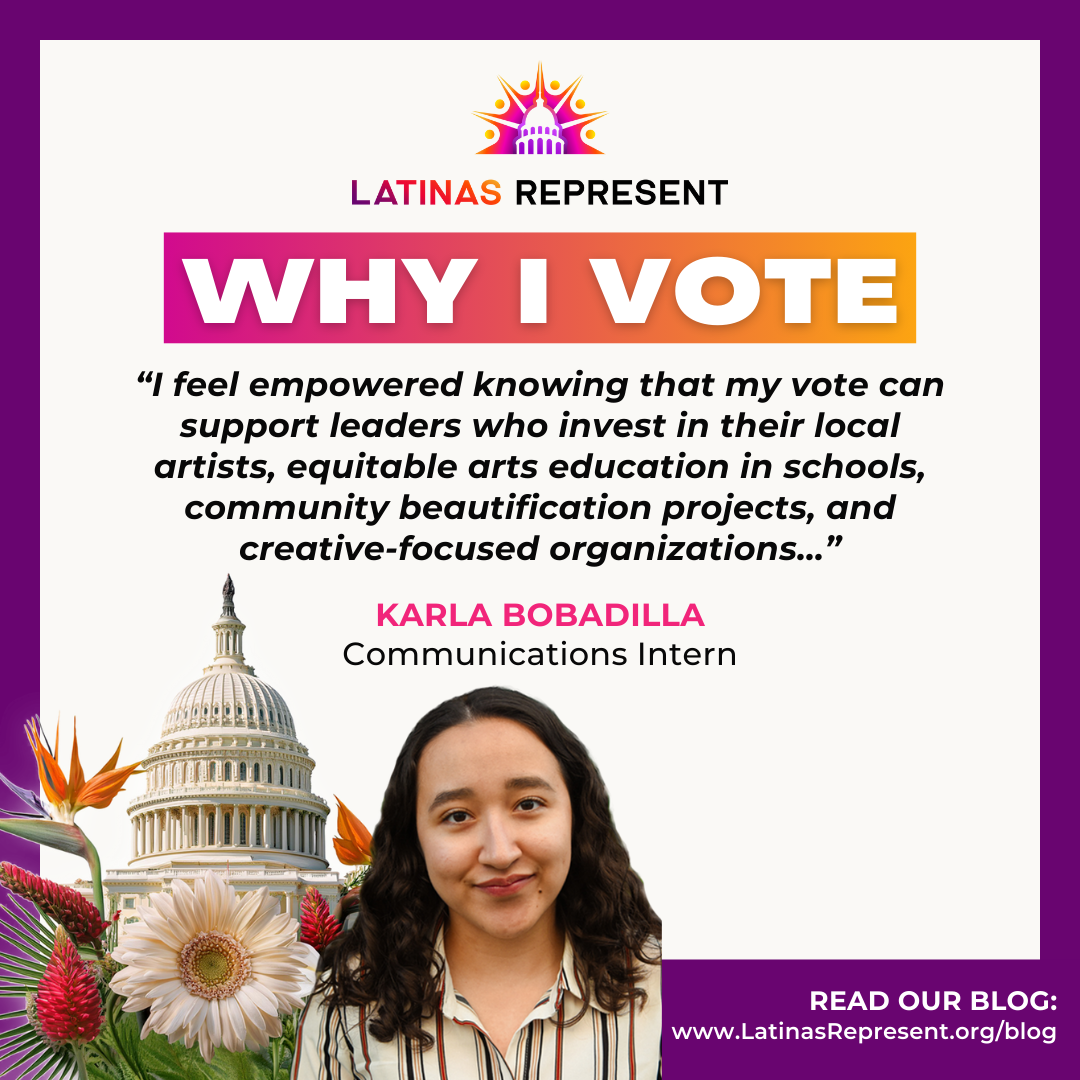
I vote because I want to use my privilege of being able to vote for good– to enrich my future and community.
It is wild to think that many years ago, women were not allowed to vote, let alone women of color. Every time I vote, I think about that struggle, its impact on my life, and how my vote will shape the future of those around me. Voting is a privilege not accessible to everyone, and unfortunately, those who do have this privilege often waste it, mainly due to a lack of self-awareness or understanding of its significance.
When I turned 18, I was excited to register to vote. I was eager to participate in the local elections and presidential primaries in 2019, even though I did not fully grasp the weight of my vote. Then came the 2020 presidential election. As the social and political climate changed rapidly, I had an “aha” moment, realizing the lack of representation of women of color and Latinas in political offices. It was both disappointing and eye-opening. While we’ve made progress, we still have a long way to go.
During the pandemic’s peak in November 2020, my sister and I were commissioned to paint a utility box mural for a neighboring city. Councilwoman Monica Rodriguez from LA County, District 7, collaborated with 11:11 Projects, an arts nonprofit organization, to beautify Pacoima with art on utility boxes, enhancing the community.
We worked along the famous Pacoima Mural Mile, close to Pacoima City Hall. Meeting Councilwoman Rodriguez and the founders of 11:11 Projects was inspiring. They were powerful women doing great things for their communities, and their dedication fueled my passion for social impact and design.
This experience guided me into numerous opportunities working with nonprofit organizations, where I could contribute my design skills and grow as both a designer and an individual. As a Latina and first-generation college student from the predominantly Latine community of the San Fernando Valley, I feel empowered knowing that my vote can support leaders who invest in their local artists, equitable arts education in schools, community beautification projects, and creative-focused organizations like 11:11 Projects.
Representation matters. I don’t see enough of it in my own city council, but I hope that changes. With my vote and active involvement, I aim to support authentic leaders who genuinely represent their communities and drive positive growth.
We aim to track Latina elected officials at all levels of government. If you are a current elected official who identifies as Latina and are not currently listed on our map, please submit your information below. Your submission will be reviewed prior to being added to the map.
Source: National Hispanic Leadership Agenda
The word Hispanic is closely tied to the U.S. government and its efforts to identify groups of people, which defines it as “Americans of Spanish origin or descent.” Under this definition, Hispanic only refers to people who are originally from Spanish-speaking countries. This term includes people from Spain but excludes people from Brazil. Although this term is widely used to describe a pan-ethnic Spanish-speaking group of people, it is not universally embraced by the communities who have been labeled as such. Due to its connection to Spanish colonization, some view the term Hispanic as a Eurocentric label that erases the Indigenous and Afro-Latino heritage of people from Latin America.
The terms Latino, Latina, Latin@, Latine, and Latinx refer to a person or group of people of Latin American or Caribbean origin or descent; this includes people from all countries in Latin America and the Caribbean but excludes Spain. When used in the singular form, Latino refers specifically to a man or boy, which is why it is necessary to use the term Latina when referring to women or girls of Latin American origin. The term “Latino” applies to a broader group of people in Spanish because the language is gendered and the masculine forms of words may also be considered gender-neutral, which means that the language itself sets a baseline that is both heterosexual and masculine and by default exclusionary. The term “Latinx” arose out of a desire to have a gender-neutral term and is used to refer to people of Latin American or Caribbean origins and is inclusive of those who identify along a gender spectrum and diverse sexual orientations and gender identities. Latinx term began appearing on the Internet in queer communities in the United States; however, it is not always considered the perfect response to the search for a postcolonial word because it requires an understanding of the English language and tends to highlight people of mestizo identity while erasing Indigenous and Afro-Latino identities. Some also have used the term “Latin@” to be inclusive, using the @ symbol to represent both an O and an A. More recently, “Latine” has emerged as an alternative to Latinx as a gender-neutral term rooted in the Spanish language. It is starting to be used in some parts of Latin America and the Caribbean and is also starting to gain some recognition in the United States.
ngshgjhrjhtrhthhewthejhfjthejhjhtjhewthewthw